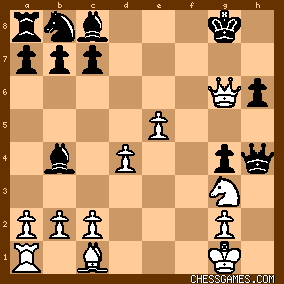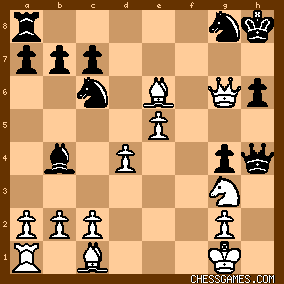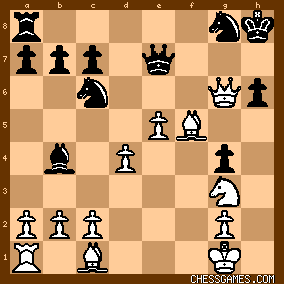|
< Earlier Kibitzing · PAGE 2 OF 3 ·
Later Kibitzing> |
| Jul-29-16 | | patzer2: Normally, demolition combinations involve sacrificing material to capture pawns on ranks adjacent to an enemy King for the purpose of exposing him to a withering attack. Today's Friday solution 16. Rxf3! demonstrates such a demolition of pawn structure, for the purpose of exposing a bare naked King to attack, can be just as effective against over-extended pawns on distant ranks. |
|
| Jul-29-16 | | patzer2: For a Black improvement, 8...Ke8  as in G Marco vs Pillsbury, 1903 looks good for the second player. as in G Marco vs Pillsbury, 1903 looks good for the second player. |
|
| Jul-29-16 | | agb2002: White is a knight down.
Black threatens 16... Qxg3.
The first idea that comes to mind is 16.Rxf3, to expose the black king and gain mobility: A) 16... gxf3 17.Qxf3
A.1) 17... Rh7 18.Qf7+ Kh8 19.Qxg8#.
A.2) 17... Qe7 18.Nh5+ Kg6 (18... Kh7 19.Qe4+ Bf5 20.Qxf5#) 19.Be4+ Bf5 20.Qxf5#. A.3) 17... Qxd4+ 18.Be3 Qxd5 (or 18... Qxe3+ 20.Qxe3) 19.Qxd5 followed by Rf1 and, in spite of the more or less balanced material [Q+P vs R+B+N], White seems to get a winning position because four pieces and a pawn can attack the black king and almost every black piece is still on its original square. A.4) 17... Nf6 18.Nh5+
A.4.a) 18... Nxh5 19.Qf7#.
A.4.b) 18... Qxh5 19.Qxf6+ Kh7 20.Bf7
A.4.b.i) 20... Qxf7 21.Qxf7#.
A.4.b.ii) 20... Qg4 21.Qxh6#.
A.4.b.iii) 20... Bg4 21.Bxh5 Bxh5 22.Bxh6 Rg8 23.Bg5 Rg6 24.Qf7+ looks winning (24... Kh8 25.Bf6+; 24... Rg7 25.Qxh5). A.4.b.iv) 20... Qd1+ 21.Kh2 + -, with the double threat 22.Qg6# and 22.Qxh6#. B) 16... Ne7 17.Rf7+
B.1) 17... Kg6 18.Qd3+ B(N)f5 19.Nxf5 wins (19... N(B)xf5 20.Qxf5#). B.2) 17... Kg8 18.Rxe7+ Kf8 19.Rxc7 with threats 20.Qf1+ and 20.Rxc8+ wins decisive material. C) 16... Nf6 17.exf6+ (17.Rxf6 Qxg3 18.Rf7+ Kg6 19.Qf1 Qe1) followed by 18.Rb3 wins a pawn at least with the better position. D) 16... c6 17.Rf7+ Kg6 18.Qd3+ Bf5 19.Qxf5#. |
|
| Jul-29-16 | | morfishine: <16.Rxf3>
***** |
|
| Jul-29-16 | | agb2002: I saw 18.Nh5+ Kf8 but forgot to analyze it (19.Nxf6 Qe1+ draws). |
|
| Jul-29-16 | | grootbrabant: <patzer2: For a Black improvement, 8...Ke8 as in G Marco vs Pillsbury, 1903 looks good for the second player.> The second player? Do you mean black? |
|
| Jul-29-16 | | beenthere240: It took me a long time to understand the lethality of 19. Bf4. |
|
| Jul-29-16 | | mel gibson: You'd have to be good to see that the sacrifice of the Rook would be a winning move. The computer saw it straight away but then black did play a lot better than here. |
|
| Jul-29-16 | | Patriot: 16.Rxf3 gxf3 17.Qxf3 but I missed the defense, 17...Nf6. 17...Qe7 18.Nh5+ ends matters quickly. I probably threw out 17...Nf6 because it just "drops a piece" but that's not a valid reason to reject it when white sacs a rook first! The rook sac made sense to not only stop blacks threat of Qxg3 but to re-capture with the queen and stir up mate threats. So 17...Nf6 is perfectly logical. I think the real difficulty begins on this move (17...Nf6), and after 18.exf6+ Kf8 (18...Qxf6 19.Nh5+  ) 19.Bf4! (not easy to find) Qxf6?? 20.Be6+ Kg7 21.Nh5+ ) 19.Bf4! (not easy to find) Qxf6?? 20.Be6+ Kg7 21.Nh5+  . 20.Qe4 threatens a simple discovered check, winning the queen, and the threats just keep going. . 20.Qe4 threatens a simple discovered check, winning the queen, and the threats just keep going. |
|
| Jul-29-16 | | Patriot: <agb2002> <White is a knight down> I never noticed this. But when you count active pieces it's not that way! Still it is important to know what the bar is before beginning to analyze, even though most of the time in these problems one can analyze correctly even without a material count. |
|
| Jul-29-16 | | kevin86: The attack is even worth a rook sacrificed. |
|
Jul-29-16
 | | Jimfromprovidence: I am having a problem figuring out the response to 16...Rh7?!
click for larger view |
|
Jul-29-16
 | | tpstar: <Jimfromprovidence> Try chopping wood with 17. Rf7+ Kh8 (17 ... Kg6 18. Qd3+ Bf5 19. Qxf5#) 18. Rxh7+ Kxh7 19. Qd3+ Kg7/Kh8 20. Bxg8 Kxg8 21. Qg6+:
click for larger view1) 21 ... Kf8 22. Bxh6+ Ke7 23. Bg5+ wins the Queen.
2) 21 ... Kh8 22. Bxh6 Qe7 (covering g7) 23. Bg5 & 24. Bf6/+ wins the Queen. |
|
Jul-29-16
 | | Jimfromprovidence: <tpstar> <Try chopping wood with 17. Rf7+ Kh8 (17 ... Kg6 18. Qd3+ Bf5 19. Qxf5#) 18. Rxh7+ Kxh7 19. Qd3+ Kg7/Kh8 20. Bxg8 Kxg8 21. Qg6+:> Thanks, mucho.
I had it slightly differently; 17 Rf7+ Kh8 18 Rxh7+ Kxh7 19 Qd3+ Kh8, then 20 Qg6. 
click for larger view
I got stuck after 20...Be6 Bxe6 21 Nc6.

click for larger viewI could not determine if white could move his knight safely because of the queen check on e1. |
|
Jul-29-16
 | | olinart: In the game played, 20 ..Qxf6 21.Be5 Qe7 22.Rf1+ Ke8
gets black out of the attack at the cost of a pawn. Nevertheless the rook sac got white out of serious trouble. |
|
| Jul-29-16 | | patzer2: <grootbrabrandt> Yes by "the second player" I mean Black. See https://en.wikipedia.org/wiki/Gloss.... |
|
| Jul-29-16 | | ruzon: <Jimfromprovidence> In your diagram, 22. Bf5 seals the deal. 22...Nf6 postpones mate by one move. |
|
| Jul-29-16 | | agb2002: <Patriot: <agb2002> <White is a knight down> I never noticed this. But when you count active pieces it's not that way! Still it is important to know what the bar is before beginning to analyze, even though most of the time in these problems one can analyze correctly even without a material count.> The material count is the very first task I consider in any position, even it's just a forced mate in two, for a number of reasons (if you don't like them I have others): -It's a matter of habit, or discipline if you like, and also the typical chess manual first step in the evaluation of a position (mainly dynamic or mainly static). -For most puzzles, it is rarely a mate in two, with the exception of Mondays which are normally only Chess 101. -One may discover an 'elegant' combination resulting in a gain of, say, two pawns but then it turns out that one only has two pawns for a piece. -The result of an attack combination might be material advantage or a better ending in which every pawn and piece counts. -For example, one may have an exchange deficit due to a previous attacking combination and have the possibility of keeping the attack alive or reach an endgame such that the bishop pair is stronger than a rook and a knight. -The material count and the interactions amongst pieces give an idea of what pieces should be kept and what could be traded or even sacrificed. -It is a simple method to slow down somewhat if one has a marked tendency to rush with the 'solution' and I'm in a rush now because my family is waiting for me to have dinner... |
|
| Jul-29-16 | | Patriot: <agb2002> (Patriot clicks the "Like" button) |
|
| Jul-29-16 | | dehanne: I knew the game as a former King's Gambit player. |
|
| Jul-29-16 | | Patriot: <agb2002>
<-One may discover an 'elegant' combination resulting in a gain of, say, two pawns but then it turns out that one only has two pawns for a piece.> This is true especially OTB. For puzzle problems where it is known there is a winning combination, usually the "maximum effect" of material or mate is correct no matter what the material count is. But I think it is more important to practice as one plays because when you play you want that kind of thinking to be automatic. One could also say that OTB there shouldn't be a need to take stock in material because you should know the material difference at all times, so jumping into "solving" a puzzle isn't necessarily out of line with that process--it's usually safe to assume the elegant combination is correct! |
|
| Jul-29-16 | | drollere: i had 16. Bf4 followed by Qd3, c3 etc.
the sacrifice is cute, but i don't see reason to rush things. the annoying Q aside black does not have a convincing attack with 2 p's, the white K is well defended by several pieces, and the black K is out in the open. the black Q sacrifice, if not a blunder, seems panicky. |
|
Jul-29-16
 | | Jimfromprovidence: <ruzon> <In your diagram, 22. Bf5 seals the deal. 22...Nf6 postpones mate by one move.> I'm not sure about the mate part because after 22 Bf5 black has 22...Qe7, below. You did answer my question, so thanks for that, since white does not have to worry about queen checks after 22...Qe7 to win. He can follow with 23 Bxh6 with multiple threats, as an example. 
click for larger view |
|
| Jul-29-16 | | DarthStapler: I got the first two moves |
|
| Jul-29-16 | | King.Arthur.Brazil: I follow the game, after my proposal, and the moves I do wrong were: 19.Bf4!... I tried Qe3. 20.Qe4!... I went on Be5? 22.Bh6+!, I did Bd6+, with same idea (now) but this is not the better move anyway, I did wrong. Again I didn't find 20.c3, but played 20.Nf5 directly that is not so good this time. I did right the two checks and Nh6, but I was expecting some answer to continue the game, but Black resignes and I feel sorry, cause I begin to enjoy the game... lgs. |
|
 |
 |
|
< Earlier Kibitzing · PAGE 2 OF 3 ·
Later Kibitzing> |





